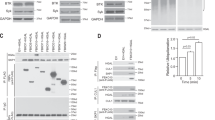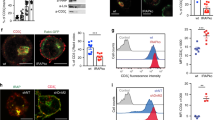Abstract
Binding of antigen to the B cell antigen receptor (BCR) triggers both BCR signaling and endocytosis. How endocytosis regulates BCR signaling remains unknown. Here we report that BCR signaling was not extinguished by endocytosis of BCRs; instead, BCR signaling initiated at the plasma membrane continued as the BCR trafficked intracellularly with the sequential phosphorylation of kinases. Blocking the endocytosis of BCRs resulted in the recruitment of both proximal and downstream kinases to the plasma membrane, where mitogen-activated protein kinases (MAPKs) were hyperphosphorylated and the kinase Akt and its downstream target Foxo were hypophosphorylated, which led to the dysregulation of gene transcription controlled by these pathways. Thus, the cellular location of the BCR serves to compartmentalize kinase activation to regulate the outcome of signaling.
This is a preview of subscription content, access via your institution
Access options
Subscribe to this journal
Receive 12 print issues and online access
$209.00 per year
only $17.42 per issue
Buy this article
- Purchase on Springer Link
- Instant access to full article PDF
Prices may be subject to local taxes which are calculated during checkout








Similar content being viewed by others
Change history
10 November 2011
In the version of this article initially published, the authors refer to the phosphorylation of Lyn observed after crosslinking of the B cell antigen receptor (BCR) as indicating activation of Lyn. However, the antibody to phosphorylated Lyn used (Cell Signaling Technologies catalog number 2731) recognizes Lyn phosphorylated at Tyr507, the negative regulatory site, and thus recognizes the inactive form of Lyn. Antibodies for the detection of the active form of Lyn (phosphorylated at Tyr396) are not available at present. However, the authors conclude that after crosslinking of the BCR, active Lyn must be in dynamic equilibrium with inactive Lyn at BCR clusters, as active Lyn is required for the observed phosphorylation of downstream kinases. They state that the following overall conclusions of the paper remain unchanged: BCR signaling is initiated at the plasma membrane and continues as the BCR traffics into the cell with sequential phosphorylation of kinases, and endocytosis is essential to regulate the outcome of signal. Nonetheless, they would like to correct this so readers are not misled about the activation state of Lyn observed in their studies. The error has been corrected in the HTML and PDF versions of the article.
References
Cambier, J.C., Gauld, S.B., Merrell, K.T. & Vilen, B.J. B-cell anergy: from transgenic models to naturally occurring anergic B cells? Nat. Rev. Immunol. 7, 633–643 (2007).
Lanzavecchia, A. Receptor-mediated antigen uptake and its effect on antigen presentation to class II-restricted T lymphocytes. Annu. Rev. Immunol. 8, 773–793 (1990).
Reth, M. & Wienands, J. Initiation and processing of signals from the B cell antigen receptor B. Annu. Rev. Immunol. 15, 453–479 (1997).
Campbell, K.S. Signal transduction from the B cell antigen-receptor. Curr. Opin. Immunol. 11, 256–264 (1999).
Kurosaki, T. Genetic analysis of B cell antigen receptor signaling. Annu. Rev. Immunol. 17, 555–592 (1999).
Dal Porto, J.M. et al. B cell antigen receptor signaling 101. Mol. Immunol. 41, 599–613 (2004).
Clark, M.R., Massenburg, D., Zhang, M. & Siemasko, K. Molecular mechanisms of B cell antigen receptor trafficking. Ann. NY Acad. Sci. 987, 26–37 (2003).
Malhotra, S., Kovats, S., Zhang, W. & Coggeshall, K.M. Vav and Rac activation in B cell antigen receptor endocytosis involves Vav recruitment to the adapter protein LAB. J. Biol. Chem. 284, 36202–36212 (2009).
Sharma, S., Orlowski, G. & Song, W. Btk regulates B cell receptor-mediated antigen processing and presentation by controlling actin cytoskeleton dynamics in B cells. J. Immunol. 182, 329–339 (2009).
Onabajo, O.O. et al. Actin-binding protein 1 regulates B cell receptor-mediated antigen processing and presentation in response to B cell receptor activation. J. Immunol. 180, 6685–6695 (2008).
Niiro, H. et al. The B lymphocyte adaptor molecule of 32 kilodaltons (Bam32) regulates B cell antigen receptor internalization. J. Immunol. 173, 5601–5609 (2004).
Mutch, C.M. et al. Activation-induced endocytosis of the raft-associated transmembrane adaptor protein LAB/NTAL in B lymphocytes: evidence for a role in internalization of the B cell receptor. Int. Immunol. 19, 19–30 (2007).
Jacob, M., Todd, L., Sampson, M.F. & Pure, E. Dual role of Cbl links critical events in BCR endocytosis. Int. Immunol. 20, 485–497 (2008).
Snyder, M.D. & Pierce, S.K. A mutation in Epstein-Barr virus LMP2A reveals a role for phospholipase D in B-cell antigen receptor trafficking. Traffic 7, 993–1006 (2006).
Malhotra, S., Kovats, S., Zhang, W. & Coggeshall, K.M. B cell antigen receptor endocytosis and antigen presentation to T cells require Vav and dynamin. J. Biol. Chem. 284, 24088–24097 (2009).
Stoddart, A., Jackson, A.P. & Brodsky, F.M. Plasticity of B cell receptor internalization upon conditional depletion of clathrin. Mol. Biol. Cell 16, 2339–2348 (2005).
Murphy, J.E., Padilla, B.E., Hasdemir, B., Cottrell, G.S. & Bunnett, N.W. Endosomes: a legitimate platform for the signaling train. Proc. Natl. Acad. Sci. USA 106, 17615–17622 (2009).
Sadowski, L., Pilecka, I. & Miaczynska, M. Signaling from endosomes: location makes a difference. Exp. Cell Res. 315, 1601–1609 (2009).
Vieira, A.V., Lamaze, C. & Schmid, S.L. Control of EGF receptor signaling by clathrin-mediated endocytosis. Science 274, 2086–2089 (1996).
Delcroix, J.-D. NGF signaling in sensory neurons: evidence that early endosomes carry NGF retrograde signals. Neuron 39, 69–84 (2003).
Omerovic, J. & Prior, I.A. Compartmentalized signalling: Ras proteins and signalling nanoclusters. FEBS J. 276, 1817–1825 (2009).
Wu, C., Lai, C.F. & Mobley, W.C. Nerve growth factor activates persistent Rap1 signaling in endosomes. J. Neurosci. 21, 5406–5416 (2001).
Kagan, J.C. et al. TRAM couples endocytosis of Toll-like receptor 4 to the induction of interferon-β. Nat. Immunol. 9, 361–368 (2008).
Stoddart, A. et al. Lipid rafts unite signaling cascades with clathrin to regulate BCR internalization. Immunity 17, 451 (2002).
Macia, E. et al. Dynasore, a cell-permeable inhibitor of dynamin. Dev. Cell 10, 839–850 (2006).
Huang, H. & Tindall, D.J. Dynamic FoxO transcription factors. J. Cell Sci. 120, 2479–2487 (2007).
Shaulian, E. & Karin, M. AP-1 as a regulator of cell life and death. Nat. Cell Biol. 4, E131–E136 (2002).
Hai, T. & Hartman, M.G. The molecular biology and nomenclature of the activating transcription factor/cAMP responsive element binding family of transcription factors: activating transcription factor proteins and homeostasis. Gene 273, 1–11 (2001).
Glynne, R. et al. How self-tolerance and the immunosuppressive drug FK506 prevent B-cell mitogenesis. Nature 403, 672–676 (2000).
Screpanti, I. et al. Lymphoproliferative disorder and imbalanced T-helper response in C/EBPβ-deficient mice. EMBO J. 14, 1932–1941 (1995).
Chen, X. et al. Impaired generation of bone marrow B lymphocytes in mice deficient in C/EBPbeta. Blood 90, 156–164 (1997).
Gazumyan, A., Reichlin, A. & Nussenzweig, M.C. Ig β tyrosine residues contribute to the control of B cell receptor signaling by regulating receptor internalization. J. Exp. Med. 203, 1785–1794 (2006).
Davis, R.E. et al. Chronic active B cell receptor signaling in diffuse large B cell lymphoma. Nature 463, 88–92 (2010).
Patterson, S.J. et al. Cutting edge: PHLPP regulates the development, function, and molecular signaling pathways of regulatory T cells. J. Immunol. 186, 5533–5537 (2011).
Gao, T., Furnari, F. & Newton, A.C. PHLPP: a phosphatase that directly dephosphorylates Akt, promotes apoptosis, and suppresses tumor growth. Mol. Cell 18, 13–24 (2005).
Astoul, E., Watton, S. & Cantrell, D. The dynamics of protein kinase B regulation during B cell antigen receptor engagement. J. Cell Biol. 145, 1511–1520 (1999).
Nazarewicz, R.R. et al. Early endosomal antigen 1 (EEA1) is an obligate scaffold for angiotensin II-induced, PKC-α-dependent Akt activation in endosomes. J. Biol. Chem. 286, 2886–2895 (2011).
Ivashkiv, L.B. Cross-regulation of signaling by ITAM-associated receptors. Nat. Immunol. 10, 340–347 (2009).
Chaturvedi, A., Dorward, D. & Pierce, S.K. The B cell receptor governs the subcellular location of Toll-like receptor 9 leading to hyperresponses to DNA-containing antigens. Immunity 28, 799–809 (2008).
O'Neill, S.K. et al. Endocytic sequestration of the B cell antigen receptor and toll-like receptor 9 in anergic cells. Proc. Natl. Acad. Sci. USA 106, 6262–6267 (2009).
Chaturvedi, A., Siddiqui, Z., Bayiroglu, F. & Rao, K.V. A GPI-linked isoform of the IgD receptor regulates resting B cell activation. Nat. Immunol. 3, 951–957 (2002).
Cheng, P.C., Dykstra, M.L., Mitchell, R.N. & Pierce, S.K. A role for lipid rafts in B cell antigen receptor signaling and antigen targeting. J. Exp. Med. 190, 1549–1560 (1999).
Acknowledgements
We thank T. Kirchhausen (Harvard Medical School) for dynasore. Supported by the Intramural Research Program of the US National Institutes of Health, National Institute of Allergy and Infectious Diseases.
Author information
Authors and Affiliations
Contributions
A.C. designed and did the experiments, analyzed data and wrote the manuscript; R.M. did experiments and analyzed the data; D.D. did TEM and interpreted the images; M.W. designed transcription analysis and analyzed the quantitative PCR data; and S.K.P. designed experiments, analyzed data and wrote the manuscript.
Corresponding authors
Ethics declarations
Competing interests
The authors declare no competing financial interests.
Supplementary information
Supplementary Text and Figures
Supplementary Figures 1–7 (PDF 9340 kb)
Supplementary Data Set
Ct values of complete data sets for Fig. 8b and 8c. (XLS 84 kb)
Rights and permissions
About this article
Cite this article
Chaturvedi, A., Martz, R., Dorward, D. et al. Endocytosed BCRs sequentially regulate MAPK and Akt signaling pathways from intracellular compartments. Nat Immunol 12, 1119–1126 (2011). https://doi.org/10.1038/ni.2116
Received:
Accepted:
Published:
Issue Date:
DOI: https://doi.org/10.1038/ni.2116
This article is cited by
-
Recreation of an antigen-driven germinal center in vitro by providing B cells with phagocytic antigen
Communications Biology (2023)
-
Bidirectional linkage between the B-cell receptor and NOTCH1 in chronic lymphocytic leukemia and in Richter’s syndrome: therapeutic implications
Leukemia (2020)
-
B cell signaling in context
Nature Immunology (2019)
-
Retrograde transport of Akt by a neuronal Rab5-APPL1 endosome
Scientific Reports (2019)
-
Mature IgM-expressing plasma cells sense antigen and develop competence for cytokine production upon antigenic challenge
Nature Communications (2016)



